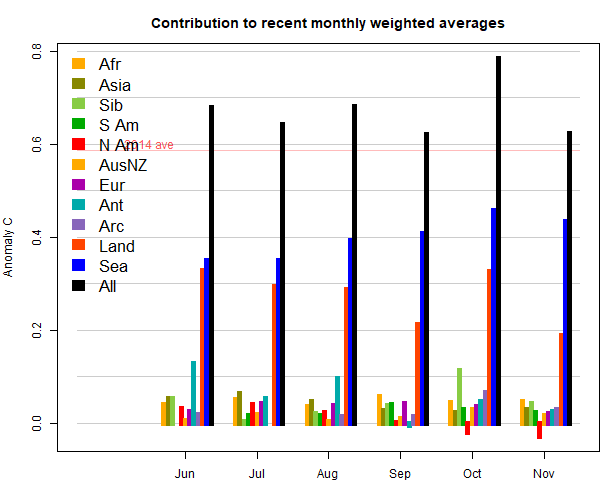The GISS land/ocean temperature anomaly rose 0.29°C last month. The October anomaly average was 0.99°C, up from September 0.74°C. A big rise, exceeding the TempLS rise of 0.166°C. Like TempLS it was the second warmest October in the record, but it was even fairly close to the highest, the the El Nino value 0f 1.08 in 2015. Jim Hansen's report is here.
The overall pattern was similar to that in TempLS. Very warm in Siberia, but extending through the Arctic (which is probably why warmer than TempLS). Cold in Canada and US prairies. Quite warm in Europe, patchy in Antarctica.
As usual here, I will compare the GISS and previous TempLS plots below the jump.
Friday, November 16, 2018
Saturday, November 10, 2018
October global surface TempLS up 0.166°C from September.
The TempLS mesh anomaly (1961-90 base) was 0.786°C in October vs 0.62°C in September. That makes it the second warmest October in the record, after 2015. The NCEP/NCAR index also showed 0.1°C, while the UAH satellite TLT index rose 0.08°C. The reanalysis showed most of the rise in a pulse in the later part of the month.
The marked feature for the last three months has been a big rise in SST, which continued. But this month land was also warm. The main hot spot was Siberia, whicle Canada/N US was cool. China was cool, Europe was warm. Here (from here) is the plot of relative contributions to the rise (ie components weighted by area):

Here is the temperature map. As always, there is a more detailed active sphere map here.

The marked feature for the last three months has been a big rise in SST, which continued. But this month land was also warm. The main hot spot was Siberia, whicle Canada/N US was cool. China was cool, Europe was warm. Here (from here) is the plot of relative contributions to the rise (ie components weighted by area):

Here is the temperature map. As always, there is a more detailed active sphere map here.

Saturday, November 3, 2018
October NCEP/NCAR global surface anomaly up 0.1°'C from September
In the Moyhu NCEP/NCAR index, the monthly reanalysis anomaly average was 0.298°C in October, up from 0.196°C in September, 2018. In the lower troposphere, UAH rose by 0.08°C. The Surface temperature had been drifting down since April, and October started on that trend, but a big rise in the second half made it the warmest month since April.
In fact, N America (especially Canada), China and W Europe were rather cool. The Arctic was warm, and E Europe; the Antarctic was patchy but mostly cool.
On El Niño from the BoM:

In fact, N America (especially Canada), China and W Europe were rather cool. The Arctic was warm, and E Europe; the Antarctic was patchy but mostly cool.
On El Niño from the BoM:
"The ENSO Outlook is set at El Niño ALERT. This means the chance of El Niño forming in 2018 is around 70%; triple the normal likelihood.
The tropical Pacific Ocean has warmed in recent weeks and is now just touching upon the El Niño threshold. Latest observations and model outlooks suggest further warming is likely, with most models indicating a transition to El Niño in November remains likely."
The tropical Pacific Ocean has warmed in recent weeks and is now just touching upon the El Niño threshold. Latest observations and model outlooks suggest further warming is likely, with most models indicating a transition to El Niño in November remains likely."
